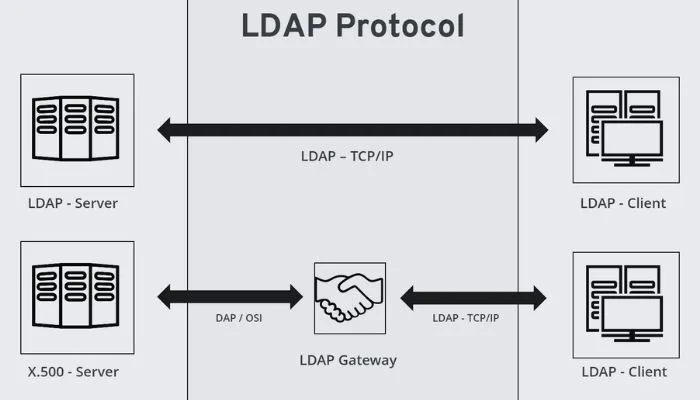What is LDAP Server?
An LDAP server is a software application that implements the LDAP protocol. It acts as a central repository for storing and managing directory information. The server allows clients to connect and perform operations such as searching, adding, modifying, and deleting directory entries.
What is the LDAP Protocol?
LDAP stands for Lightweight Directory Access Protocol. It is an open, industry-standard protocol used for accessing and maintaining distributed directory information services over a network. LDAP is widely used in various applications, including authentication, authorization, and directory services.
Learn more What is LDAP (Lightweight Directory Access Protocol)
Features of LDAP Server
LDAP servers offer several key features that make them an essential component of many organizations’ IT infrastructure:
- Scalability: LDAP servers can handle large amounts of directory data and support thousands of concurrent connections.
- Security: LDAP servers provide various security mechanisms, including authentication and encryption, to protect sensitive directory information.
- Flexibility: LDAP servers support a wide range of directory data types, allowing organizations to store and manage diverse information.
- Interoperability: LDAP servers are compatible with different operating systems and applications, making it easier to integrate them into existing IT environments.
How Does an LDAP Server Work?
LDAP is a basic technology that is very important for organizing and getting directory information. Itis uses TCP/IP to work within. Let’s take a quick look at how an LDAP server works:

- Client-Server Interaction: LDAP works with a client-server model. The server is the LDAP server that saves the directory information. The client is a device or application that needs this information. In order to get the information it needs, the client talks to the server.
- Querying for Information: The computer sends a question to the LDAP server to start the process. This query asks for specific data, like information about users, positions in groups, or how devices are set up. It is the server’s job to find this information and give it to you.
- Organized Directory Structure: LDAP servers are set up in a way that looks like a tree: they are organized in a hierarchy. The root directory is at the very top, and there are many other directories below it. Each branch holds a different type of information, and each leaf holds a unique piece of information. This structure makes it possible to handle data in an organized way.
- Distinguished Names (DNs): A Distinguished Name (DN) is a unique number that is assigned to each item in the directory. The DN tells you where in the directory tree the thing is. A user’s DN might look like this: “CN=John Doe, OU=Sales, DC=example, DC=com.” CN stands for “Common Name,” OU for “Organizational Unit,” and DC for “Domain Component.”
- Data Retrieval: The LDAP server looks through the directory for the item whose DN matches the query. It gets the desired data once it finds the object. With this tiered setup, it’s easier to find data and keep things organized.
- Security and Authentication: In LDAP, security is very important. The server makes sure that the directory can only be accessed by people who are allowed to. Usually, this is done through authentication, in which clients must provide proper credentials (like a username and password) to show who they are. Access control lists, or ACLs, tell the server what data can be accessed by which users.
- Data Management: LDAP servers can do more than just get data; they can also change and handle data. Clients can add to the directory, change items, or delete them. Because it is so flexible, LDAP is a great way to keep data safe and organized.
- Integration with Other Services: LDAP servers often work with a number of different services and apps. For instance, they work well with email systems, methods for authenticating users, and Single Sign-On (SSO) solutions. This integration makes things easier for users and makes it easier to control network resources.
LDAP servers store and retrieve data quickly and easily within a well-organized directory system. They are necessary for managing modern networks because they provide safe and organized ways to view and manage data.
Common Use Cases of LDAP Server
LDAP servers have numerous use cases across various industries and organizations:
- Authentication and Authorization: LDAP servers are commonly used for user authentication and authorization. They store user credentials and access control information, allowing organizations to control user access to resources.
- Directory Services: LDAP servers serve as a centralized directory service, storing information about users, groups, devices, and other directory objects. This information can be accessed by applications and services within the organization.
- Single Sign-On (SSO): LDAP servers can be integrated with SSO solutions to provide a seamless login experience for users. Users only need to authenticate once to gain access to multiple applications and services.
- Email and Collaboration: LDAP servers are often used in email and collaboration platforms to store user contact information, address books, and distribution lists.
Popular LDAP Servers
There are several LDAP server implementations available, both open-source and commercial. Some of the popular ones include:
- OpenLDAP: OpenLDAP is a widely used open-source LDAP server that is known for its scalability, flexibility, and extensive documentation.
- Microsoft Active Directory: Active Directory is a commercial LDAP server provided by Microsoft. It is commonly used in Windows-based environments for user and group management.
- Novell eDirectory: eDirectory is a commercial LDAP server developed by Novell. It is known for its robustness, security features, and multi-platform support.
LDAP servers play a crucial role in managing directory information and providing essential services for organizations. Whether it is for authentication, authorization, or directory services, LDAP servers offer a reliable and scalable solution.

